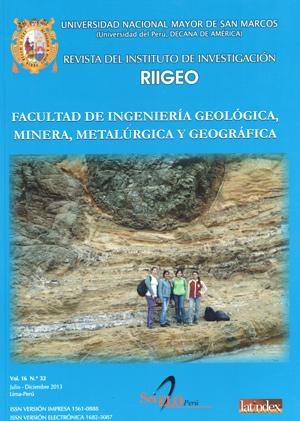Hydrometallurgical processing of complex sulphide ores Cashew for obtaining nickel and its salts
DOI:
https://doi.org/10.15381/iigeo.v16i32.11323Keywords:
Extractive metallurgy, X rays, metallurgical processes, Marañón geological complex, metallic nickelAbstract
Peru maintains a leading position in the world mining in connection to production and extraction of metals like copper, zinc, silver, gold among others. Geological exploration and prospecting already carried out, show us a promissory future for the above mentioned minerals and other interesting findings like nickel in millerite ore which was proved in some ore deposits of the Marañón geological complex.
This occurrence allowed us to carry out metallurgical investigation, specifically hydrometallurgical processing for the Peruvian sulphide ore aimed to the development of profitable mining operations for both private sector and the Peruvian state. We showed the metallurgical test results carried out at the metallurgical engineering school related to obtaining metallic nickel plates and its by products like cement and sulphate crystals.
Downloads
Published
Issue
Section
License
Copyright (c) 2013 Daniel Lovera, J. Arroyo, C. Landauro, V. Arias, J. Quiñones, M. Pillaca, L. Puente, L. Sanchez, M. Terrel, J. Medina, J. Diego, H. Chilon

This work is licensed under a Creative Commons Attribution-NonCommercial-ShareAlike 4.0 International License.
AUTHORS RETAIN THEIR RIGHTS:
a. Authors retain their trade mark rights and patent, and also on any process or procedure described in the article.
b. Authors retain their right to share, copy, distribute, perform and publicly communicate their article (eg, to place their article in an institutional repository or publish it in a book), with an acknowledgment of its initial publication in the Rev. Inst. investig. Fac. minas metal cienc. geogr.
c. Authors retain theirs right to make a subsequent publication of their work, to use the article or any part thereof (eg a compilation of his papers, lecture notes, thesis, or a book), always indicating the source of publication (the originator of the work, journal, volume, number and date).






